San Diego Bay study examines fish consumption habits among local anglers

SCCWRP and its partners have completed a comprehensive, two-year study illuminating the fish consumption habits of San Diego Bay anglers who catch fish that could potentially be contaminated.
The San Diego Bay Fish Consumption Study, published as a technical report in April, found that while average consumption rates were below thresholds of concern, certain demographic populations consumed San Diego Bay fish at significantly higher rates that, in some cases, exceeded consumption guidelines.
The findings will be used to inform development of fish consumption guidelines that are specific to San Diego Bay. A similar fish consumption study in Santa Monica Bay – completed more than two decades ago by SCCWRP – was used in the development of statewide fish consumption guidelines.
The San Diego Bay findings are based on a survey of more than 1,000 anglers over a one-year period. The survey data were gathered by individually approaching and interviewing anglers at public piers, on boat ramps and along the shoreline. SCCWRP used a custom-designed tablet app to store and transmit the data.
Anglers were asked what types of fish they catch from the bay, how often they consume these fish and whether they are aware of existing fish consumption advisories. About half of survey participants reported being aware of consumption guidelines, although it did not appear to affect their decision to consume fish from the bay.
More news related to: Sediment Quality, Sediment Quality Assessment Frameworks